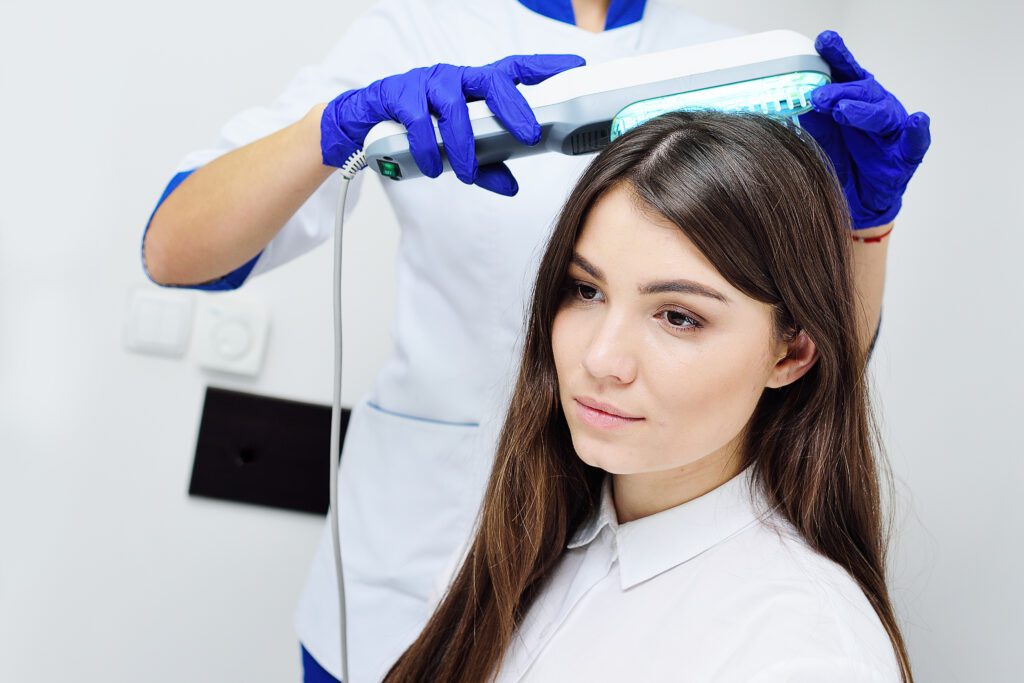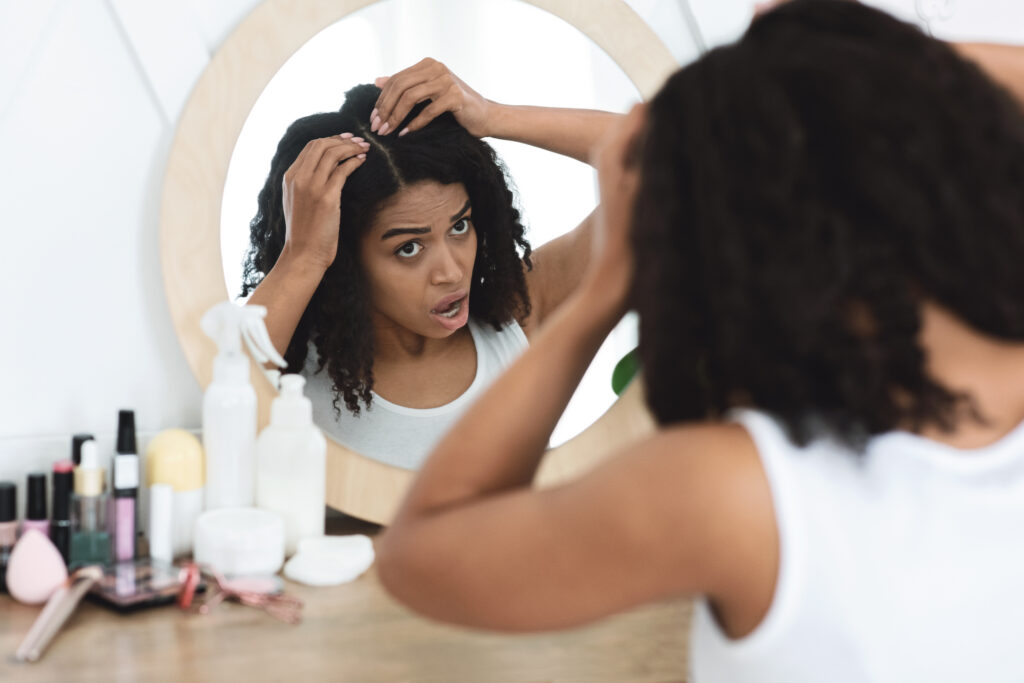Hair loss is a common concern affecting millions of people worldwide. The impact on an individual’s self-esteem and confidence can be significant whether genetics, hormonal imbalances, stress, or certain medical conditions cause it. While various treatment options have emerged, low-level light therapy (LLLT) has gained attention as a non-invasive and promising approach to combat hair loss.

What Exactly Is Low-Level Light Therapy
Low-Level Light Therapy, also known as LLLT or photobiomodulation therapy, involves using specific wavelengths of light energy to stimulate cellular activity and promote hair growth. These therapeutic light sources emit low levels of laser or LED light, targeting the scalp and stimulating the hair follicles.
Mechanisms of Action
Enhanced blood circulation
LLLT increases blood flow in the scalp and stimulates microcirculation around the hair follicles. This improved circulation provides essential nutrients and oxygen necessary for hair growth.
Anti-inflammatory effects
LLLT has been found to reduce inflammation in the scalp, which can contribute to hair loss. When specific wavelengths of light are applied to the skin, it activates cellular processes that promote healing, reduce inflammation, and alleviate pain. LLLT stimulates the mitochondria within cells, improving their energy production and releasing chemical signals that regulate inflammation. By modulating the immune response and reducing pro-inflammatory cytokines, LLLT helps to calm and soothe the body’s inflammatory pathways and, thus, creates an environment conducive to hair growth.
Cell metabolism and protein synthesis
Light energy absorbed by the hair follicles stimulates cellular processes, promoting DNA synthesis, cell proliferation, and protein synthesis. The mitochondria absorb the photons emitted by the low-level light sources, the powerhouse of the cell, which then leads to the production of adenosine triphosphate (ATP). ATP provides energy to the cells, promoting their growth and function. Additionally, LLLT is believed to decrease the activity of dihydrotestosterone (DHT), a hormone that contributes to hair loss in individuals with a genetic predisposition. These factors contribute to the growth and maintenance of healthy hair.
Benefits of LLLT as Hair Loss Treatment
Non-invasive
Unlike surgical hair restoration methods, LLLT is a non-invasive treatment without incisions, making it safe and painless.
Convenient and Easy to Use
LLLT can be performed at home using handheld devices or through in-office sessions. The treatments are usually short, requiring only a few minutes daily or weekly, depending on the device used.
Effectiveness and Clinical Studies
Numerous studies have been conducted to evaluate the effectiveness of LLLT in treating hair loss. Research findings indicate that LLLT can be a valuable addition to the arsenal of hair loss treatments. A randomized controlled trial published in the American Journal of Clinical Dermatology in 2014 demonstrated that LLLT increased hair density in men and women suffering from androgenetic alopecia, a common form of hair loss. Another study published in Lasers in Surgery and Medicine in 2019 found that LLLT resulted in significant hair regrowth in individuals with alopecia areata, an autoimmune condition causing patchy hair loss.
Side Effects of LLLT
Low-level light therapy is generally considered safe and well-tolerated. However, like any medical treatment, there can be potential side effects, which are typically minimal and temporary. Below are some possible side effects of using LLLT for hair loss treatment.
Mild Scalp Irritation
Some individuals may experience mild scalp irritation, itching, or redness during or after LLLT sessions. However, these effects are usually temporary and subside quickly.

Dryness or Flakiness
In some cases, LLLT may cause temporary dryness or flakiness of the scalp. Patients can manage this by ensuring proper scalp hydration and using moisturizing products, if necessary.
Headaches
Rarely individuals may experience a mild headache following LLLT treatment sessions. If this occurs, it is advisable to consult with a healthcare professional.
What’s the Verdict?
Low-level light therapy offers a promising solution for individuals struggling with hair loss. Its non-invasive nature, safety profile, and demonstrated effectiveness make it an attractive option for those seeking to restore their hair and regain confidence. While LLLT may not be a universal cure for all types and severities of hair loss, it has shown remarkable potential as an adjunctive treatment in combination with other therapeutic approaches. As the field of hair restoration continues to evolve, LLLT holds a bright future in the fight against hair loss. As always, if you’re considering trying out LLLT or any other hair loss treatment, it is essential to consult with a qualified dermatologist before pursuing the specific treatment type.
Frequently Asked Questions
Can I use LLLT to treat my hair loss if I’m Norwood 6?
LLLT is better suited for the initial stages of hair loss. If your hair loss has progressed to NW 6 already, you should consult a dermatologist to find the best treatment option for you.
After how many uses will I notice an improvement if I use a home device?
You would need to use a home LLLT device at least 8-10 times, for 10-15 minutes each time. Allow about two weeks between treatment sessions.
References
(No date) Efficacy and safety of a low-level laser device in the treatment of … Available at: https://dash.harvard.edu/bitstream/handle/1/12152951/3986893.pdf?sequence=1 (Accessed: 12 July 2023).
Farivar, S., Malekshahabi, T. and Shiari, R. (2014) Biological effects of low-level laser therapy, Journal of lasers in medical sciences. Available at: https://www.ncbi.nlm.nih.gov/pmc/articles/PMC4291815/ (Accessed: 12 July 2023).
Henderson, R. by E. (2021) Low-level laser treatment can stimulate hair follicles and hair growth, expert finds, News. Available at: https://www.news-medical.net/news/20210920/Low-level-laser-treatment-can-stimulate-hair-follicles-and-hair-growth-expert-finds.aspx#:~:text=%22This%20low%2Dlevel%20laser%20therapy,10%20times%2C%20every%20two%20weeks (Accessed: 12 July 2023).
NE;, A.M. (no date) The use of low-level light for hair growth: Part I, Journal of cosmetic and laser therapy : official publication of the European Society for Laser Dermatology. Available at: https://pubmed.ncbi.nlm.nih.gov/19466643/ (Accessed: 12 July 2023).
N;, P.R.T. (no date) Quantitative proteomic analysis of dermal papilla from male androgenetic alopecia comparing before and after treatment with low-level laser therapy, Lasers in surgery and medicine. Available at: https://pubmed.ncbi.nlm.nih.gov/30843235/ (Accessed: 14 July 2023).
Pillai, J.K. and Mysore, V. (2021) Role of low-level light therapy (LLLT) in androgenetic alopecia, Journal of cutaneous and aesthetic surgery. Available at: https://www.ncbi.nlm.nih.gov/pmc/articles/PMC8906269/#:~:text=Studies%20have%20shown%20that%20LLLT,in%20both%20males%20and%20females (Accessed: 12 July 2023).


